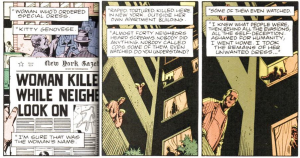Difference between revisions of "Genovese Syndrome"
| Line 1: | Line 1: | ||
[[File:Kitty_Genovese.jpg|200px|thumb|right|Ms. Genovese]] | [[File:Kitty_Genovese.jpg|200px|thumb|right|Ms. Genovese]] | ||
The '''Genovese Syndrome''', otherwise known as the Bystander Effect, is a social phenomenon that refers to the situation where a group of people do not help a victim in the event of an emergency. The more people who witness the event, the less of a chance that the people watching the event will intervene. The mere fact that other people are around will affect the way we interact with the person who is in need in help. One reason for this is that when more people are around, there is a higher chance that a person will miss an emergency event, think that event does not require help, or think that someone else will help instead. Because of this, they will affect the other people watching to follow their same actions, resulting in the entire group of people not following what they normally do as a result of their own morals. Recent research has shown, that in contrast to popular belief, the Bystander effect does not occur in situations that are considered to be emergencies. In fact the fact that there are bystanders around make people more likely to help out. This is because people are able to give each other moral support when there is grave need, such as a stabbing or rape. | The '''Genovese Syndrome''', otherwise known as the Bystander Effect, is a social phenomenon that refers to the situation where a group of people do not help a victim in the event of an emergency. The more people who witness the event, the less of a chance that the people watching the event will intervene. The mere fact that other people are around will affect the way we interact with the person who is in need in help. One reason for this is that when more people are around, there is a higher chance that a person will miss an emergency event, think that event does not require help, or think that someone else will help instead. Because of this, they will affect the other people watching to follow their same actions, resulting in the entire group of people not following what they normally do as a result of their own morals. Recent research has shown, that in contrast to popular belief, the Bystander effect does not occur in situations that are considered to be emergencies. In fact the fact that there are bystanders around make people more likely to help out. This is because people are able to give each other moral support when there is grave need, such as a stabbing or rape. | ||
| + | ([[Tops & Categories|Back to index]]) | ||
| + | |||
=History= | =History= | ||
The murder of Catherine Susan Genovese was the case that resulted in the discovery of the Bystander effect. Catherine Susan Genovese, otherwise known as Kitty Genovese, was stabbed to death in Queens, NY on March 13, 1964. The story goes that Kitty was stabbed in the back twice. As she was stabbed, Kitty screamed twice. This was heard by several neighbors, who all ignored the cry. Half an hour later, the same assailant came back and stabbed and rape Kitty again. At the time, it was reported that 38 people was close enough to observe or hear this event. After the police investigated, only two people were aware that the attacked occurred. This story was the catalyst for the research that showed the Genovese effect. More recent data has shown that this story is somewhat overblown that in the end, only about a dozen people were around during the attack. | The murder of Catherine Susan Genovese was the case that resulted in the discovery of the Bystander effect. Catherine Susan Genovese, otherwise known as Kitty Genovese, was stabbed to death in Queens, NY on March 13, 1964. The story goes that Kitty was stabbed in the back twice. As she was stabbed, Kitty screamed twice. This was heard by several neighbors, who all ignored the cry. Half an hour later, the same assailant came back and stabbed and rape Kitty again. At the time, it was reported that 38 people was close enough to observe or hear this event. After the police investigated, only two people were aware that the attacked occurred. This story was the catalyst for the research that showed the Genovese effect. More recent data has shown that this story is somewhat overblown that in the end, only about a dozen people were around during the attack. | ||
Revision as of 06:43, 25 November 2011
The Genovese Syndrome, otherwise known as the Bystander Effect, is a social phenomenon that refers to the situation where a group of people do not help a victim in the event of an emergency. The more people who witness the event, the less of a chance that the people watching the event will intervene. The mere fact that other people are around will affect the way we interact with the person who is in need in help. One reason for this is that when more people are around, there is a higher chance that a person will miss an emergency event, think that event does not require help, or think that someone else will help instead. Because of this, they will affect the other people watching to follow their same actions, resulting in the entire group of people not following what they normally do as a result of their own morals. Recent research has shown, that in contrast to popular belief, the Bystander effect does not occur in situations that are considered to be emergencies. In fact the fact that there are bystanders around make people more likely to help out. This is because people are able to give each other moral support when there is grave need, such as a stabbing or rape. (Back to index)
History
The murder of Catherine Susan Genovese was the case that resulted in the discovery of the Bystander effect. Catherine Susan Genovese, otherwise known as Kitty Genovese, was stabbed to death in Queens, NY on March 13, 1964. The story goes that Kitty was stabbed in the back twice. As she was stabbed, Kitty screamed twice. This was heard by several neighbors, who all ignored the cry. Half an hour later, the same assailant came back and stabbed and rape Kitty again. At the time, it was reported that 38 people was close enough to observe or hear this event. After the police investigated, only two people were aware that the attacked occurred. This story was the catalyst for the research that showed the Genovese effect. More recent data has shown that this story is somewhat overblown that in the end, only about a dozen people were around during the attack.
Explanation of Effect
There are currently several theories as to the origin of this effect. The most popular idea is that humans look to other people to verify what a situation actually is. We use their reactions as a clue to what an appropriate reaction to a certain situation is. As the number of people increase, it becomes easier for people to put the responsibility to act on another person. If only one person sees an event, he or she may feel guilty for not helping a person out. However if many people are around, that person can believe that other people will help and therefore he or she will not need to help. Because of this, there is not guilt from this person for not helping.
Applicability to online environment
There has been considerable controversy over whether the internet is allowing people to lead unmoral lives online. The ability for users to be anonymous is one of the reasons that online users feel that they are able to do normally unmoral activities online. Being anonymous means that one is not held accountable for their actions. The Bystander effect is partially based on a person seeing what the other people around him are reacting to a certain situation. This is hard to do in a virtual world since you are unable to physically see how other people react. Also, online users are conditioned to ignore other online users in order to prevent time being wasted over reading flame wars or comments from people who are trolling. Because of this, the Bystander effect is inapplicable to the online environment. The result of this is that people then follow their own morals online. Therefore, when talking only about groups of people, the online environment creates a situation where one is more likely to be more unmoral in real life than in the virtual world.

